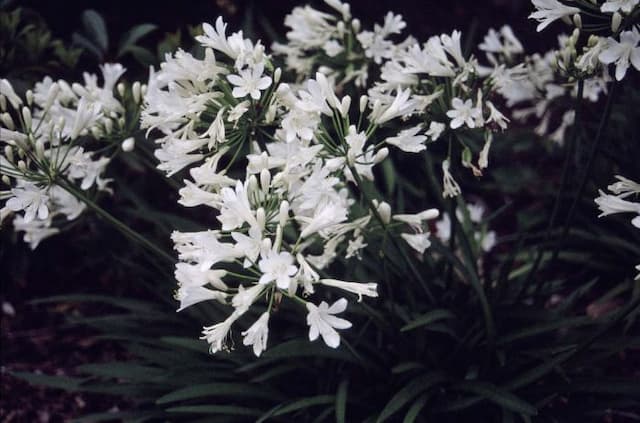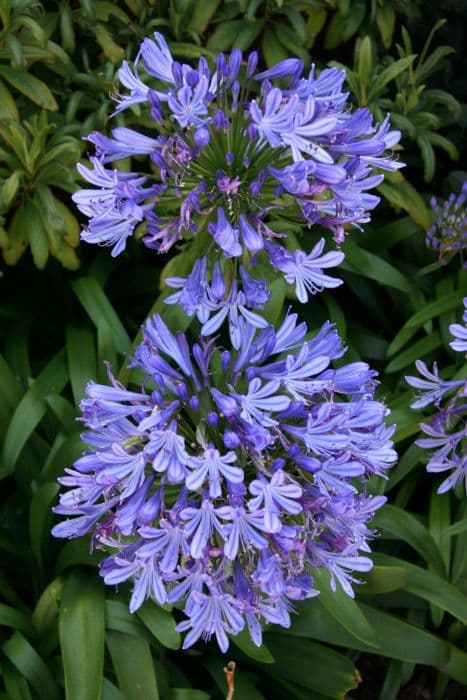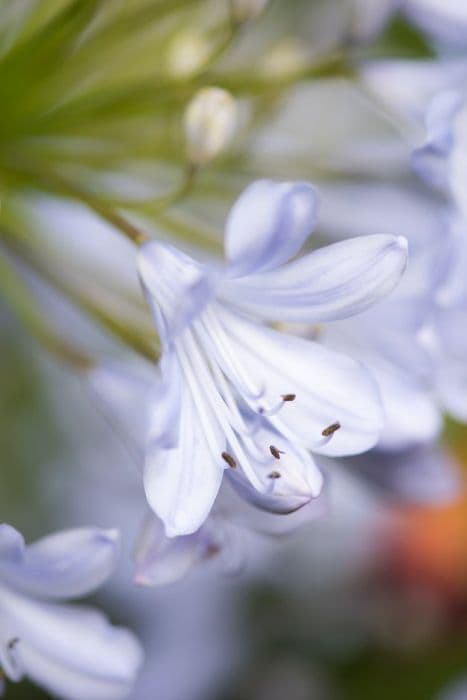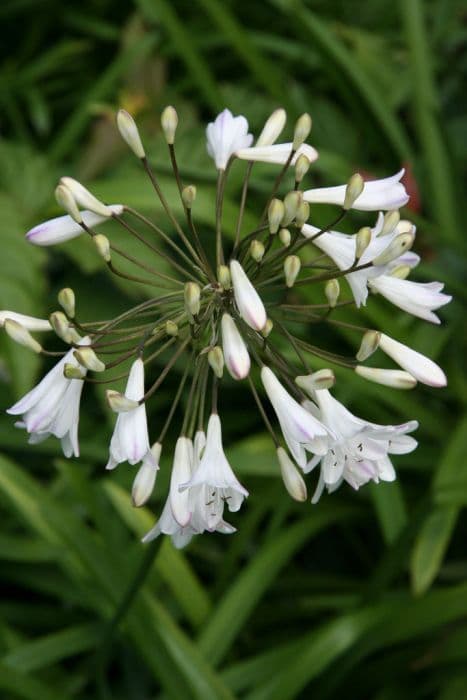African Lily Agapanthus Blue Storm = 'Atiblu' (PBR) (Storm Series)
![African lily [Blue Storm]](/_next/image?url=https%3A%2F%2Fplants-admin.emdemapps.com%2Fimages%2Fplants%2F%2Fimages%2F604b63200a08b.png&w=3840&q=75)
ABOUT
The Agapanthus Blue Storm, part of the Storm Series, is a strikingly ornamental garden plant renowned for its vibrant floral display. This plant is characterized by its lush, strap-shaped, green leaves which form a dense clump. Rising above the foliage are sturdy stems that bear rounded clusters of trumpet-shaped flowers. The blossoms of the Blue Storm are a deep blue hue, presenting a bold and eye-catching presence in the landscape. The flowers within each cluster are numerous and tightly grouped, creating a spherical or umbrella-like shape at the top of each stem. These floral umbels create a visual impact that resembles a storm of blue hues, which is likely the inspiration behind the plant's cultivar name. The Agapanthus Blue Storm blooms generously, with the flowers persisting and providing a visual spectacle during its flowering season. This plant is often favored in garden designs for its ease of growth and its ability to bring a burst of color to borders, beds, and containers.
About this plant
 Names
NamesSynonyms
African Lily, Lily Of The Nile, Love Flower.
Common names
Agapanthus 'ATIblu', Agapanthus praecox subsp. orientalis 'Blue Storm'.
 Toxicity
ToxicityTo humans
The Agapanthus, commonly known as Lily of the Nile or African Lily, is not highly toxic to humans, but it does contain compounds that can cause mild to moderate symptoms if ingested. These can include nausea, vomiting, and diarrhea. In some cases, skin contact with the sap may result in irritation or dermatitis. While the plant is not typically life-threatening, eating parts of it, especially in large quantities, should be avoided to prevent any adverse reactions.
To pets
The Agapanthus or Lily of the Nile is considered toxic to pets, particularly cats and dogs. If a pet ingests part of this plant, symptoms such as vomiting, diarrhea, nausea, and drooling may occur. In severe cases, ingesting it can lead to lethargy and other signs of generalised weakness. It is important to prevent pets from chewing on or ingesting the plant to avoid any potential poisoning. If you suspect your pet has ingested Agapanthus, contact a veterinarian immediately.
 Characteristics
CharacteristicsLife cycle
Perennials
Foliage type
Evergreen
Color of leaves
Green
Flower color
Blue
Height
2 feet (60 cm)
Spread
2 feet (60 cm)
Plant type
Herb
Hardiness zones
8
Native area
South Africa
Benefits
 General Benefits
General Benefits- Attractive Blooms: Agapanthus Blue Storm features striking blue flowers that add a vibrant splash of color to any garden or landscape.
- Drought Tolerance: Once established, it has good resistance to drought, reducing the need for frequent watering.
- Low Maintenance: This plant typically requires minimal care, making it an ideal choice for gardeners looking for high-impact plants with low effort.
- Long Blooming Period: Offers an extended blooming season compared to some other garden plants, ensuring a display of color for a longer time.
- Attracts Pollinators: The blooms attract butterflies and bees, which are vital for pollinating other plants in the garden.
- Perennial Growth: As a perennial, it returns yearly, providing consistent structure and color.
- Hardy: It can withstand a variety of conditions and is relatively hardy once acclimatized, making it suitable for different climates.
- Container-Friendly: Suitable for container planting, allowing it to be used on patios, balconies, or other areas where ground planting isn't an option.
- Deer Resistant: Less appealing to deer, which can be beneficial in areas where deer browsing is a problem.
- Architectural: Its foliage and flower shape provide a strong architectural element to garden designs.
 Medical Properties
Medical PropertiesThis plant is not used for medical purposes.
 Air-purifying Qualities
Air-purifying QualitiesThis plant is not specifically known for air purifying qualities.
 Other Uses
Other Uses- Artistic Inspiration: The striking blue-violet blooms of the Agapanthus can provide a vivid color palette for artists and inspire paintings, textiles, or other forms of artwork.
- Garden Themed Parties: Use Agapanthus as a motif for garden parties or outdoor events, creating a cohesive and elegant atmosphere based on the flower's color and shape.
- Photographic Subjects: Photographers can use the intricate structure of the Agapanthus flowers as a subject for macro photography or to enhance portrait backgrounds.
- Educational Tool: Horticulture educators may use the Agapanthus to teach gardening techniques such as division or to illustrate how to care for perennials.
- Floral Crafts: The stems and flowers can be used in creating dried floral arrangements or potpourri due to their durability and shape.
- Landscape Design: Agapanthus can be used in landscape architecture to create patterns or as a border plant, adding depth and contrast in garden design.
- Gastronomy Events: While not commonly consumed, the unique look of Agapanthus can be used to adorn plates or as a non-toxic garnish in culinary presentations for special events.
- Nature-Inspired Jewelry: The shape and color of Agapanthus flowers can inspire the design of jewelry, such as brooches, pendants, or earrings, where its form is replicated in precious metals or stones.
- Eco-Friendly Confetti: Dried petals of Agapanthus can serve as biodegradable confetti for outdoor celebrations, minimizing environmental impact.
- Stamp Design: Philatelists or stamp designers might feature the Agapanthus on postage stamps as a representation of natural flora and gardening heritage.
Interesting Facts
 Feng Shui
Feng ShuiThe African Lily is not used in Feng Shui practice.
 Zodiac Sign Compitability
Zodiac Sign CompitabilityThe African Lily is not used in astrology practice.
 Plant Symbolism
Plant Symbolism- Love Letters: Agapanthus is often associated with love and is sometimes called the "Love Flower." The name itself is derived from the Greek words 'agape,' meaning love, and 'anthos,' meaning flower.
- Beauty: The striking blue blooms of the Agapanthus make it a symbol of beauty and attractiveness in the garden, symbolizing an appreciation for natural beauty.
- Endurance: Agapanthus plants are known for their toughness and ability to thrive in difficult conditions, making them a symbol of endurance and resilience.
- Fertility: With its lush foliage and round clusters of flowers, the plant is sometimes associated with fertility and abundance.
- Protection: In some cultures, Agapanthus is believed to ward off evil spirits and is therefore seen as a symbol of protection.
- Freedom: Due to its wild origin and its ability to spread in the garden, the Agapanthus is also a symbol of freedom and free-spirited nature.
 Water
WaterThe Lily of the Nile should be watered deeply once a week, allowing the soil to dry out between waterings. During the growing season, in the absence of rainfall, provide about an inch of water each week. In hotter, drier periods, increase watering slightly. During the dormant winter months, reduce watering to every few weeks, just enough to prevent the soil from completely drying out. Always avoid waterlogging as this can cause root rot.
 Light
LightLily of the Nile thrives in full sunlight to partial shade. Ideally, it should receive at least six hours of sunlight per day. A spot that gets morning sunlight and afternoon shade is optimal, especially in regions with hot summers.
 Temperature
TemperatureLily of the Nile prefers a temperate climate with temperatures ideally between 50°F and 80°F. It can survive temperatures down to about 20°F, but frost can damage the foliage. Above 80°F, the plant still grows well but ensure it isn't subjected to prolonged periods of extreme heat without adequate watering.
 Pruning
PruningPrune the Lily of the Nile to remove spent flower stalks and to tidy up any dead or damaged leaves. The best time for pruning is late winter or early spring before new growth begins. This will encourage the new buds to develop and keep the plant looking neat.
 Cleaning
CleaningAs needed
 Soil
SoilThe best soil mix for Agapanthus, commonly known as African Lily or Lily of the Nile, should be rich, well-draining, and have a pH range from 6.0 to 8.0. A blend of two parts loam, one part perlite or coarse sand, and one part compost or well-rotted manure will create an optimal environment for 'Atiblu' Agapanthus growth.
 Repotting
RepottingAfrican Lily or Agapanthus 'Atiblu' should be repotted every 2 to 3 years or when the roots have filled the pot. It's best to repot during spring before the new growth starts, using a slightly larger pot to allow for growth.
 Humidity & Misting
Humidity & MistingAfrican Lily or Agapanthus 'Atiblu' prefers moderate humidity levels. It thrives best in outdoor conditions where the natural humidity is sufficient. If grown indoors, typical room humidity is usually adequate for this plant, avoiding overly dry air.
 Suitable locations
Suitable locationsIndoor
Place Agapanthus 'Atiblu' in bright indirect light indoors.
Outdoor
Plant Agapanthus 'Atiblu' in full sun to partial shade.
Hardiness zone
8-11 USDA.
 Life cycle
Life cycleThe Lily of the Nile 'Atiblu' begins its life as a dormant rhizome or seed, depending on the method of propagation. Upon germination or emergence from dormancy, it first develops a rosette of strap-like leaves that grow outward from the plant’s base. As it matures, sturdy stalks rise above the foliage, culminating in globes of trumpet-shaped, blue flowers that bloom in summer. Following the flowering stage, seed pods may form if pollination occurs, whereas spent flowers will wither and can be deadheaded to encourage further blooming. During the autumn, the plant’s above-ground growth starts to die back as it enters a period of dormancy, conserving energy within its rhizomes for the next growing season. With the return of warmer temperatures and adequate watering in spring, the Lily of the Nile 'Atiblu' breaks dormancy and the cycle repeats.
 Propogation
PropogationPropogation time
Spring to Early Summer
Propogation: The most popular method of propagating the Agapanthus Blue Storm, also known as African Lily, is through division. The best time to divide Agapanthus is in the spring, just as new growth begins to emerge. Gardeners should carefully lift the clump from the soil and use a sharp knife or spade to divide the root ball into smaller sections, each with at least one growing point or shoot. These sections can then be replanted in a well-draining soil mix, ensuring that the crown of the plant is just at or slightly above the soil surface. It's important to water these new divisions thoroughly to help them establish.









